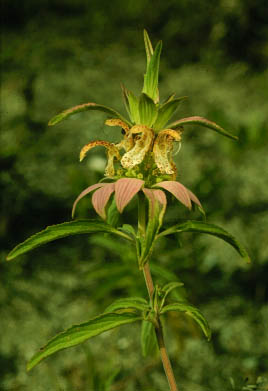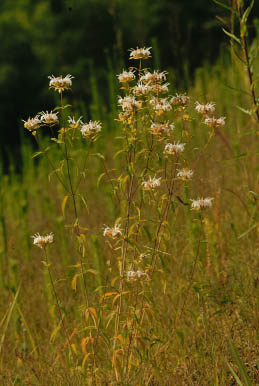
Monarda punctata
Courtesy of the UGA Herbarium

Monarda punctata
Courtesy of the UGA Herbarium
Monarda punctata
|
Monarda punctata Courtesy of the UGA Herbarium |
Monarda punctata Courtesy of the UGA Herbarium |
Author: Gwen Kathryn Ewald
~~~~~~~~~~~~~~~~~~~~~~~~~~~~~~~~~~~~~~~~~~~~~~~~~~~~~~~~~~~~~~~~~~
|
Common Names: (Niering, 1979; Grimm, 1933) · Dotted Monarda· Spotted Horsemint· HorsemintHigher Taxa: · Class: Magnoliopsida · Order: Lamiales · Family: Lamiaceae (Labiatae) · Tribe: Monardeae · Genus: Monarda · Subgenus: Cheilyctis · Species: punctata |
 Drawing of Monarda punctata by Gwen Ewald |
Identification: This species of Monarda was also named by Dr. Nicholas Monardes in his 1569 herbal of American flora. The name punctata, from the Latin punctatum meaning "a point", is easily attributed to the purple-spotted yellow flowers that it bears (Klimas, 1974).
Monarda punctata is described as follows, "this species has a stem 2 to 3 feet tall; with narrowly lance-shaped, shallowly toothed leaves which are pointed at both ends. The upper ones and the bracts of the flower cluster are lilac-pink to whitish. The inch-long yellow flowers are spotted with purple and have a very slender, arching upper lip." in The Illustrated Book of Wildflowers and Shrubs (Grimm, 1933).
Geography: Monarda punctata is found growing in sandy soils along or near coastal plains, south from Long Island (Klimas, 1974). M. punctata is native from Massachusetts to Ontario and Wisconsin south to Florida, Mississippi and Arkansas (Grimm, 1933).
|
Monarda punctata |
|
AREA |
STATUS |
REFERENCES |
|
North America: Continental United States; Canada |
Yes |
|
|
Eastern North America: United States east of Mississippi; Ontario and eastern Canada |
Yes |
|
|
Southeastern United States:AL AR DE DC FL GA KY MD NC SC TN VA WV |
Yes |
|
|
Coastal Plain |
Yes |
|
|
Piedmont |
No |
|
|
Blue Ridge Mountains |
Yes |
|
|
Ridge and Valley |
? |
- |
|
Cumberland Plateau |
? |
- |
|
Central Arch |
? |
- |
|
Georgia |
Yes |
|
|
Clarke County, Georgia |
Yes |
|
|
Sams Farm |
? |
- |
|
Old Field |
? |
- |
|
Wetland |
unlikely |
Not sandy soils |
|
Woods |
Possible |
In sandier areas |
|
1-Hectare Plot |
? |
- |
General Information: This member of the Horsemints blooms late in July through September, and makes an excellent ornamental plant in sandy soils (Grimm, 1933). M. punctata has the highest thymol content of all the mints(Shimizu, 1997). M. punctata can be used for a variety of medicinal purposes, usually external. An infusion can be used to for colic, as a diaphoretic and diuretic and is a rubefacient, stimulant, and is carminative (Grieve).